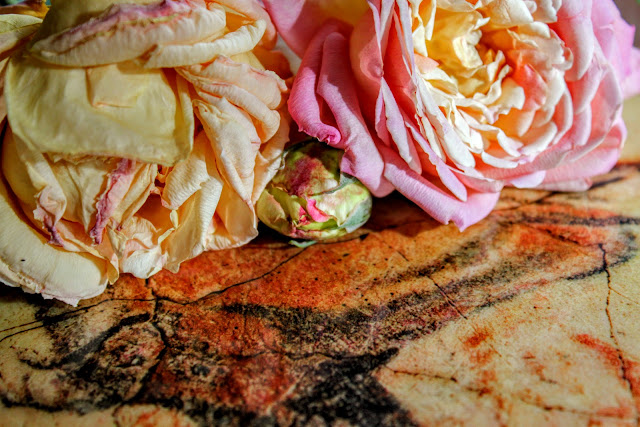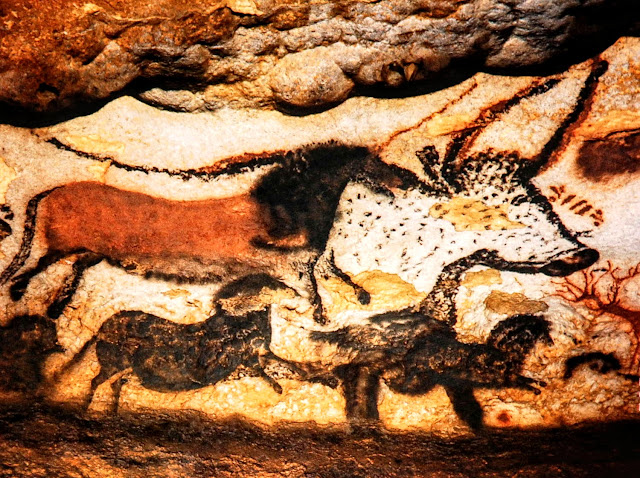Monday, 27 November 2017
Widow's Endorphins: Adding Soul to the Chicken Soup
Widow's Endorphins: Adding Soul to the Chicken Soup: Divas of the flower world, Coral Peonies are loved for their large, showy, vivid coral pink coloured blossoms. They're found in...
Adding Soul to the Chicken Soup
Divas of the flower world, Coral Peonies are loved for their large, showy, vivid coral pink coloured blossoms. They're found in elegant, sophisticated bridal bouquets, and sweeping hotel centre pieces. In the true diva spirit, these peonies are fine dramatic performers, playing leading roles in Asian, Californian or French inspired floral arrangements. So powerful, so show stopping, you often need only one in an arrangement.
You'd think they'd be arrogrant. On the contrary, Coral Peonies don't take themselves seriously at all! They laugh at themselves. They're comedians!
At the centre of each bowl shaped blossom of peony petals, are hot pink tipped stigmas, surrounded by golden stamens, heavy with pollen. They look like five chickens in a nest! Once you've seen it, you can't unsee it. It's the private joke between you, and the diva...the lowering of the sunglasses, to give you a secret wink! I love this flower for that alone!
I made my own chicken stock the other night. It's something I've done for decades. As I boiled the bones of what had been a roast chicken, the heady fragrance of what would soon be chicken soup, filled my home. That night, I drained the flavourful stock, chilled it, and the next morning, I skimmed off the fat. Then, I put it back in the fridge, where it sat for a week. I ditched it on Saturday.
This ridiculous ritual has gone on many times over the past three years. Widowhood seems to have claimed my joy of cooking - and I don't mean my dog eared and smudged cookbook. I've lost my mojo. I need to add soul to my chicken soup.
There was a time when I would have made my Christmas cakes by now, and had them doused in rum or brandy, wrapped in cheesecloth, and stored away in a cupboard. Late November and December nights would see me baking shortbread cookies, gingersnaps, double chocolate cookies, and desert moons (cream cheese pastry filled with a date, orange and walnut mixture). This year, I haven't even started.
"Whatsamatta? You chicken, or somethin'?", my inner voice asks.
I'm not chicken! It takes a lot of pluck to go back into the kitchen after a culinary disaster. This year, there've been plenty. I baked a superb cheesecake for twenty-five guests at one event, and when I tried to replicate it for a special birthday a few months later, it was overbaked and grainy. It left me with egg on my face!
With Christmas just weeks away, I've promised myself that my home will once again be filled with the sweet scent of cinnamon, oranges and chocolate. It will be filled with the sound of Christmas music, and the laughter of friends. My kitchen is getting its soul back!
I've been channeling the vibrant, powerful, and joyful Coral Peony, and my heart shouts, "this chick can bake"!
Photographs Copyright of: Ruth Adams, Widow's Endorphins Photographic Images Incorporated.
Sunday, 19 November 2017
Widow's Endorphins: Golden November
Widow's Endorphins: Golden November: November's honey coloured afternoon light falls softly, and lingers for a short time. For a few days more, the Toronto skyline ...
Golden November
November's honey coloured afternoon light falls softly, and lingers for a short time. For a few days more, the Toronto skyline is bejeweled with leaves of topaz, amber and gold. The air is different. You can smell the snow in the air, and there's a scent of wood smoke rising from stately brick homes of the city.
Darkness comes early. With it, the city fills with glowing lights. Strings of Christmas lights begin to appear in trees, along fences, and over archways. Shop windows take on a warm, glow; and candle light shimmers from restaurant tables, as couples lean in closer, to listen to stories of the day.
In kitchens around the city, the lights are on, while dinner is being prepared - fresh pasta boiling on the stove in one house, big bowls of chicken soup next door, and curried vegetables being heaped on dinner plates across the street.
November. Curling up inside on a rainy night, reading under the warm glow of candescent lamplight. Golden moments.
November. Curling up inside on a rainy night, reading under the warm glow of candescent lamplight. Golden moments.
Thursday, 9 November 2017
Widow's Endorphins: From Cave Drawings to Synthetic Biology
Widow's Endorphins: From Cave Drawings to Synthetic Biology: Creative expression is primal. Whether you are an artist, or a scientist, creativity is in the DNA of mankind. Cave drawings have been...
From Cave Drawings to Synthetic Biology
Creative expression is primal. Whether you are an artist, or a scientist, creativity is in the DNA of mankind. Cave drawings have been found in Indonesia, Australia, Europe, the USA, and Canada, some dating back as far as 40-thousand years ago.
Every day, as I sit down to a meal, I find myself staring at the ochre and zinc oxide animal images from the Altamira caves in Spain, and the famous Lascaux caves in the Dordogne Region of France. I may not eat a Paleo Diet, however, I do have paleolithic images on my placemats!
The drawings are powerful. They incorporate every bump in the cave walls, giving the bulls, horses and other animals a 3D effect, at once becoming both paintings and sculptures. There's also a strong sense of movement. One of the first people to see Lascaux's Hall of Bulls, described it as a, "cavalcade of animals larger than life painted on the walls and ceiling of the cave; each animal seemed to be moving". One of the bulls stretches 5.18 metres (17 feet) across the cave wall - the largest cave drawing of an animal anywhere in the world.
The Don himself, started exploring and excavating the caves in 1875, and found bones of extinct giant stag, wild horses, and bison. Four years later, he found paleolithic implements. The biggest find, would be made by his young daughter.
Depending on what account you read, Maria was five, six, eight, nine, eleven or twelve years old, when she accompanied her father on one of his archaeological excavations. He was not far away from her, when he heard her call, "toros!" Bulls, barely visible on the cave ceiling. Well, bison actually, said her father. Maria had discovered what would eventually be known as the "Sistine Chapel of Prehistory". Eventually...
French archeologists, were less than impressed. They didn't believe that, "primative people could create such art". The nobleman was accused of fraud. They said an artist, living in the castle, painted the cave drawings himself, and it was an elaborate hoax by one con artist, and his artist. Don Sanz de Sautuda died in 1888, fifteen years before he would be proven honest and right.
Between 1895 and 1901, more art was found in caves in Northern Spain and in France (there are about 340 such caves in the region). In 1902, one of the late nobleman's worst accusers, French archaeologist Emile Cartailhac, published, "Mea Culpa d'un Sceptique", in the journal L'Anthropology. Maria's father was vindicated, and his descendants would go on to become Bankers (with a capital B)!
The caves are breathtaking. With every inhaled gasp, there's an exhale of carbon dioxide. For every muddy shoe that steps into the caves, and every hand that touches the walls, there's bacteria from the outside. The carbon dioxide, humidity, and contaminants have all caused disintegration of the cave drawings in both Altamira and Lascaux. In 1998, fungus, blamed on a newly installed air conditioning system, began appearing in the Lascaux caves, causing black and white stains. In 2008, a black mold appeared.
Lascaux has a protective layer of chalk, which preserved the paintings for millenia, by making the cave waterproof. It took modern man only a few decades to disturb the ecosystem. As Yvan Moenne Loccose, Lascaux's Microbiologist says, the "cave has its own microbiota, whose balance has only recently been disrupted by man".
Little can be done about the bacteria, fungus and mold. They tried fungicides, antibiotics, and chemicals. New micro-organisms would appear. Right now, they're only scratching the surface. Yes, actually, scratching the walls with a monthly mechanical and chemical treatment. Time is not on the side of this World Heritage Site.
The young scientists used their collective genius, and creative ideas to find a possible solution, using synthetic biology to restrain the damage. They sought input from other scientists, and the people who live in the region. They created a bacterium that would kill bacteria, and linked it to a toxin/anti-toxin system, that will kill the bacterium if it mutates. To prevent the new bacterium from leaving the cave, they implanted a biological switch inside the bacterium, that would kill the bacterium once it detected too much light. Think: vampire bacteria!
Despite being closed for years, tourists are still trekking to the caves of Altamira and Lascaux. In France, there's an exact replica of the Lascaux Caves, built in 1983. It only has two of the halls, however, they're the most famous ones. Ironically, after the cries of "fake", that greeted the news of the Altamira discovery, a complete replica of the Spanish site was built in 2001. It is tourist friendly, with good lighting, hand rails, and a smooth, even floor. Unfortunately, no one is allowed to take pictures - with or without a flash. You have to buy the book.
More caves are being discovered all the time...in June 2016, 70 paleolithic cave paintings were discovered in Basque country. The 14-thousand year old Atxurra caves are said to be, "pristine".
More caves are being discovered all the time...in June 2016, 70 paleolithic cave paintings were discovered in Basque country. The 14-thousand year old Atxurra caves are said to be, "pristine".
...and yes, those are the last of the Chicago Peace tea roses which grew on my balcony all Summer and Fall.
Altamira and Lascaux images from Wiki Images.
Photographs Copyright of: Ruth Adams, Widow's Endorphins Photographic Images Incorporated.
Subscribe to:
Comments (Atom)


















